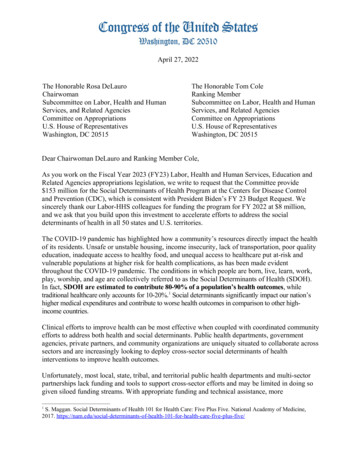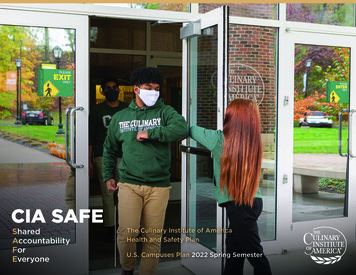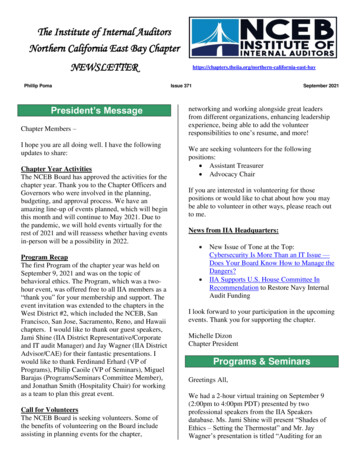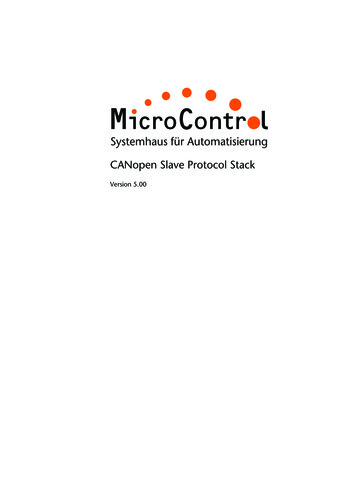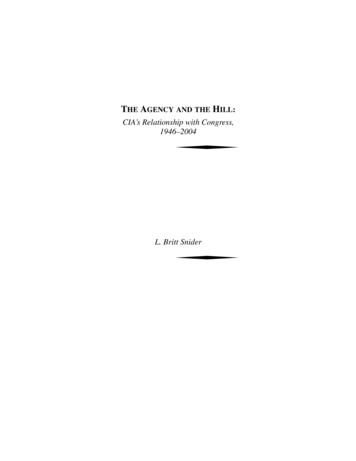
Transcription
THE AGENCY AND THE HILL:CIA’s Relationship with Congress,1946–2004L. Britt Snider
The Center for the Study of IntelligenceCSI was founded in 1974 in response to Director of Central Intelligence James Schlesinger’s desire to create within CIA an organization that could “think through the functions of intelligence and bringthe best intellects available to bear on intelligence problems.” Thecenter, comprising professional historians and experienced practitioners, attempts to document lessons learned from past operations,explore the needs and expectations of intelligence consumers, andstimulate serious debate on current and future intelligence challenges.To support these activities, CSI publishes Studies in Intelligenceand books and monographs addressing historical, operational, doctrinal, and theoretical aspects of the intelligence profession. It alsoadministers the CIA Museum and maintains the Agency’s HistoricalIntelligence Collection.Comments and questions may be addressed to:Center for the Study of IntelligenceCentral Intelligence AgencyWashington, DC 20505Printed copies of this book are available to requesters outside the USgovernment from:Government Printing Office (GPO)Superintendent of DocumentsPO Box 391954Pittsburgh, PA 15250-7954Phone (202) 512-1800E-mail: Orders@gpo.govISBN: 978-1-929667-17-8GPO Stock#: 04101500257-1All statements of fact, opinion, or analysis expressed in this bookare those of the author. They do not necessarily reflect official positions of the Central Intelligence Agency or any other US governmententity, past or present. Nothing in the contents should be construed asasserting or implying US government endorsement of the author’sfactual statements and interpretations.
THE AGENCY AND THE HILL
The Center for the Study of IntelligenceCentral Intelligence AgencyWashington, DC 20505Library of Congress Cataloguing-in-Publications DataSnider, L. BrittThe Agency and the Hill:CIA’s Relationship with Congress, 1946–2004/L. Britt SniderIncludes bibliographic references, index.ISBN 978-1-929667-17-8 (pbk.:alk paper)1. Intelligence—United States. 2. Congress.3. Intelligence history. 4. Intelligence oversight.5. Intelligence organization. 6. Intelligence management.7. Intelligence policy.Typeset in Times.Printed by Imaging and Publication Support, CIA.
THE AGENCY AND THE HILL:CIA’s Relationship with Congress,1946–2004L Britt SniderCenter for the Study of IntelligenceCentral Intelligence AgencyWashington, DC2008
CONTENTSPreface . . . . . . . . . . . . . . . . . . . . . . . . . . . . . . . . . . . . . . . . . . . .xiiiPART I: WHAT THE RELATIONSHIP WAS LIKEChapter 1: THE NATURE OF THERELATIONSHIP, 1946–76 . . . . . . . . . . . . . . . . . . . . . . . . . . 3The Central Intelligence Group (1946–47) . . . . . . . . . . . . . . 3The Early Oversight Arrangements: 1947–56 . . . . . . . . . . . . 5The Mansfield Resolutions: 1953–55 . . . . . . . . . . . . . . . . . 11Debate in the Senate: 1956 . . . . . . . . . . . . . . . . . . . . . . . . . 14Subsequent Developments: 1956–59 . . . . . . . . . . . . . . . . . 17The Issue of GAO Audits: 1959–62 . . . . . . . . . . . . . . . . . . . 20Shootdown of the U-2: 1960 . . . . . . . . . . . . . . . . . . . . . . . . 21The Bay of Pigs: 1961 . . . . . . . . . . . . . . . . . . . . . . . . . . . . . 21The Remainder of the 1960s: A Period of Quiescence . . . . 23McCone’s Early Interaction with the Congress . . . . . . . . . . 23CIA Interaction with the Congress: 1963–66 . . . . . . . . . . . 25The SFRC Asserts Its Right to Oversee the CIA: 1966 . . . 261971: A Pivotal Year . . . . . . . . . . . . . . . . . . . . . . . . . . . . . . 27Congressional Inquiries into Watergate: 1973–74 . . . . . . . . 28Congressional Inquiries into the CIAActivities in Chile: 1973–74 . . . . . . . . . . . . . . . . . . . . . . . . 31Allegations of Domestic Spying and OtherAbuses: 1974–75 . . . . . . . . . . . . . . . . . . . . . . . . . . . . . . . . 33The Church Committee: 1975–76 . . . . . . . . . . . . . . . . . . . . 35The Nedzi/Pike Committees: 1975–76 . . . . . . . . . . . . . . . . 37AUTHOR’S COMMENTARY . . . . . . . . . . . . . . . . . . . . . . . .The Early Congressional Arrangements: 1947–76 . . . . . .The Joint Committee “Panacea” . . . . . . . . . . . . . . . . . . . .The Personalities, Attitudes, and Circumstancesof the Early DCIs . . . . . . . . . . . . . . . . . . . . . . . . . . . . . . . . .39394243CHAPTER 2: THE RELATIONSHIP: 1976–2004 . . . . . . . . . 51The Senate Select Committee on Intelligence: 1976 . . . . . . 51The House Permanent Select Committeeon Intelligence: 1977 . . . . . . . . . . . . . . . . . . . . . . . . . . . . . . 53v
CONTENTS1977–80: The Committees Prove Themselves . . . . . . . . . . .The Intelligence Oversight Act of 1980 . . . . . . . . . . . . . . . .The Mining of the Nicaraguan Harbors andthe Casey Accords: 1984 . . . . . . . . . . . . . . . . . . . . . . . . . . .Term Limits as an Issue for the SSCI: 1984 . . . . . . . . . . . .GAO Again: 1984 . . . . . . . . . . . . . . . . . . . . . . . . . . . . . . . .Continued Wrangling over CovertAction Notification: 1985–86 . . . . . . . . . . . . . . . . . . . . . . .Tightening Control over Intelligence Funding: 1986 . . . . . .Investigating the Iran-contra Affair: 1986–87 . . . . . . . . . . .Changes to Congressional OversightPrompted by Iran-contra: 1987–91 . . . . . . . . . . . . . . . . . . .GAO Audits Resurface: 1987–88 . . . . . . . . . . . . . . . . . . . .The Creation of a Statutory InspectorGeneral for the CIA: 1989 . . . . . . . . . . . . . . . . . . . . . . . . . .Statutory Recognition of the Agency’sSupport of Congress: 1992 . . . . . . . . . . . . . . . . . . . . . . . . .Formalization of Notification Procedures:The Guatemala Inquiries, 1995 . . . . . . . . . . . . . . . . . . . . . .Procedures for “Whistleblowers” Who Wishedto Contact Congress: 1998 . . . . . . . . . . . . . . . . . . . . . . . . .The Joint Inquiry into the 9/11 Attacks: 2001–2003 . . . . . .Criticism from the 9/11 Commission and anEnd to Term Limits: 2004 . . . . . . . . . . . . . . . . . . . . . . . . . .56596061626263646668686970717374AUTHOR’S COMMENTARY . . . . . . . . . . . . . . . . . . . . . . . . 75What Changed When the Select Committees Were Created 75The Joint Committee Solution . . . . . . . . . . . . . . . . . . . . . . 76Term Limits for Members of the Select Committees . . . . 77The Impact of Personalities, Attitudes,and Circumstances . . . . . . . . . . . . . . . . . . . . . . . . . . . . . . . . 78CHAPTER 3: INTELLIGENCE-SHARING ANDOTHER INTERACTION . . . . . . . . . . . . . . . . . . . . . . . . . . . 93The Early Period: 1947–75 . . . . . . . . . . . . . . . . . . . . . . . . . 94After the Creation of the Select Committees: 1976-2004 . 114AUTHOR’S COMMENTARY . . . . . . . . . . . . . . . . . . . . . . .Significance of the Incidental Interaction with CongressWhy Congress Needs Intelligence Support . . . . . . . . . . .The Impact of Intelligence-Sharing with the Congress . .vi120120121122
CONTENTSCHAPTER 4: ORGANIZATIONAL ARRANGEMENTSAT THE CIA . . . . . . . . . . . . . . . . . . . . . . . . . . . . . . . . . . . 125One-Man Operations . . . . . . . . . . . . . . . . . . . . . . . . . . . . .An Expanded Office of Legislative Counsel: 1976–81 . .Casey and Congress: 1981–86 . . . . . . . . . . . . . . . . . . . . . .Responding to Iran-Contra: 1986–90 . . . . . . . . . . . . . . . . .Strengthening Ties to the Hill afterthe Guatemala Episode: 1995 . . . . . . . . . . . . . . . . . . . . . .The Office of Congressional Affairs: 1988–2004 . . . . . . .125127128130130131AUTHOR’S COMMENTARY . . . . . . . . . . . . . . . . . . . . . . . 132The Agency’s Arrangements for Dealingwith the Congress . . . . . . . . . . . . . . . . . . . . . . . . . . . . . . . 132PART II: WHAT THE RELATIONSHIP PRODUCEDCHAPTER 5: LEGISLATION . . . . . . . . . . . . . . . . . . . . . . . . 137The Agency’s Original Charter: Section 202of the National Security Act of 1947 . . . . . . . . . . . . . . . .The CIA Act of 1949 . . . . . . . . . . . . . . . . . . . . . . . . . . . . .Additional Legislation: 1949–64 . . . . . . . . . . . . . . . . . . . .The Foreign Intelligence Surveillance Act of 1978 . . . . . .The Classified Information Procedures Act of 1980 . . . . .The Intelligence Identities Protection Act of 1982 . . . . . .Exemption from the Freedom ofInformation Act for CIA: 1984 . . . . . . . . . . . . . . . . . . . . .The CIA Inspector General Act of 1989 . . . . . . . . . . . . . .The Intelligence Reorganization Act of 1992 . . . . . . . . . .Naming of the Headquarters Compound: 1998 . . . . . . . . .The Intelligence Reform and TerrorismPrevention Act of 2004 . . . . . . . . . . . . . . . . . . . . . . . . . . .AUTHOR’S COMMENTARY . . . . . . . . . . . . . . . . . . . . . . .Legislating Missions and Authorities for the CIA . . . . . . .The President and Intelligence Legislation . . . . . . . . . . . .What Never Made It Through the Congressional Mill . . TER 6: PROGRAM AND BUDGET . . . . . . . . . . . . . . 159The Transition from CIG to CIA: 1946–47 . . . . . . . . . . . . 159Covert Action: Funding a New Mission for the Agency . . 161vii
CONTENTSInteraction in the Early Years: 1948–52 . . . . . . . . . . . . . .Interaction during the Eisenhower Years: 1953–60 . . . . . .The Agency Headquarters Building: 1951–56 . . . . . . . . . .Developments in the 1960s and Early 1970s . . . . . . . . . . .Consideration of the Budget Process bythe Church and Pike Committees . . . . . . . . . . . . . . . . . . .Budget Oversight by the Select Committeeson Intelligence: 1977–81 . . . . . . . . . . . . . . . . . . . . . . . . . .Interaction During the ReaganAdministration: 1981–89 . . . . . . . . . . . . . . . . . . . . . . . . . .The End of the Cold War and Its Effecton the Budget: 1989–95 . . . . . . . . . . . . . . . . . . . . . . . . . .Return to Relative Stability and ModestIncreases: 1995–2000 . . . . . . . . . . . . . . . . . . . . . . . . . . . .The Impact of the 9/11Attacks: 2001–2004 . . . . . . . . . . . . . . . . . . . . . . . . . . . . . .AUTHOR’S COMMENTARY . . . . . . . . . . . . . . . . . . . . . . .Exercising Power of the Purse . . . . . . . . . . . . . . . . . . . . .Hiding within the Defense Budget . . . . . . . . . . . . . . . . . .The Quality of Budget Oversight . . . . . . . . . . . . . . . . . . .The Impact of Budget Oversight . . . . . . . . . . . . . . . . . . TER 7: OVERSIGHT OF ANALYSIS . . . . . . . . . . . . 193The Early Years: 1947–74 . . . . . . . . . . . . . . . . . . . . . . . . .The Church and Pike Committees . . . . . . . . . . . . . . . . . . .Early Interaction with the Select Committees: 1976–80 . .Later Interaction Regarding Analytical Issues: 1980–90 . .The Iraqi Invasion of Kuwait and thePersian Gulf War: 1990–91 . . . . . . . . . . . . . . . . . . . . . . . .The Gates Confirmation Hearings: 1991 . . . . . . . . . . . . . .Interaction with the SelectCommittees 1991– 2000 . . . . . . . . . . . . . . . . . . . . . . . . . .193199201204207210212AUTHOR’S COMMENTARY . . . . . . . . . . . . . . . . . . . . . . . 220The Nature of the Interaction over Analysis . . . . . . . . . . 220The Implications of Sharing Intelligencefor Oversight . . . . . . . . . . . . . . . . . . . . . . . . . . . . . . . . . . . 222viii
CONTENTSCHAPTER 8: OVERSIGHT OF COLLECTION . . . . . . . . . 223Early Congressional Awareness of EspionageOperations: 1947–60 . . . . . . . . . . . . . . . . . . . . . . . . . . . . .Early Technical Collection: The U-2and CORONA Programs . . . . . . . . . . . . . . . . . . . . . . . . . .The Cuban Missile Crisis: 1962–63 . . . . . . . . . . . . . . . . . .Contact with Respect to the Nosenko Case: 1967 . . . . . . .Helms and the Leaders of the CIASubcommittees: 1966–73 . . . . . . . . . . . . . . . . . . . . . . . . .The Church Committee’s Investigation of CIADomestic Activities: 1975–76 . . . . . . . . . . . . . . . . . . . . . .The Church Committee’s Look at LiaisonRelationships: 1976 . . . . . . . . . . . . . . . . . . . . . . . . . . . . . .The Pike Committee’s Treatment ofOperational Issues: 1975–76 . . . . . . . . . . . . . . . . . . . . . . .Early Involvement of the SSCI inOperational Matters: 1976–80 . . . . . . . . . . . . . . . . . . . . . .Early HPSCI Involvement inOperational Matters: 1977–80 . . . . . . . . . . . . . . . . . . . . .Executive Order 12333 and Limits onDomestic Activities: 1981 . . . . . . . . . . . . . . . . . . . . . . . . .SSCI Inquiry into “Death Squads” inEl Salvador: 1984 . . . . . . . . . . . . . . . . . . . . . . . . . . . . . . .HPSCI Inquiry into Cuban Operations: 1987 . . . . . . . . . .HPSCI Inquiry into the Agency’sRelationship with Manuel Noriega: 1988 . . . . . . . . . . . . .The SSCI’s Consideration of ArmsControl Treaties: 1987–92 . . . . . . . . . . . . . . . . . . . . . . . .The SSCI’s Reviews of CIA Support toMilitary Operations: 1990–91 . . . . . . . . . . . . . . . . . . . . . .The SSCI’s Banca Nazionale del LavoroInvestigation: 1992–93 . . . . . . . . . . . . . . . . . . . . . . . . . . .The Guatemala Inquiries and theirAftermath: 1995–96 . . . . . . . . . . . . . . . . . . . . . . . . . . . . .CIA Use of Journalists, Clergy, andPeace Corps Volunteers: 1996 . . . . . . . . . . . . . . . . . . . . .Alleged Involvement in Crack CocaineSales in Los Angeles: 1996–2000 . . . . . . . . . . . . . . . . . . .CIA’s Role in the Accidental Bombing of theChinese Embassy in Belgrade: 1999 . . . . . . . . . . . . . . . . .SSCI Inquiry into the Shootdown of 43244245245246ix
CONTENTSCivilian Aircraft in Peru: 2001 . . . . . . . . . . . . . . . . . . . . .Operational Issues in the Joint Report on 9/11: 2002 . . . .Inquiries into Counterterrorism Activities: 2003–04 . . . . .Operational Issues in the SSCI’s Inquiry intothe Prewar Intelligence Assessments on Iraq: 2004 . . . . .HPSCI Criticism of the DO: 2004 . . . . . . . . . . . . . . . . . . .247248250AUTHOR’S COMMENTARY . . . . . . . . . . . . . . . . . . . . . . .Collection in General . . . . . . . . . . . . . . . . . . . . . . . . . . . .Congress and Espionage . . . . . . . . . . . . . . . . . . . . . . . . .Congress and the Agency’s Technical Collection . . . . . .253253253255250252Chapter 9: OVERSIGHT OF COVERT ACTION . . . . . . . . . 259Congressional Awareness and Involvement from1948 until the Bay of Pigs . . . . . . . . . . . . . . . . . . . . . . . . .The Bay of Pigs: 1961 . . . . . . . . . . . . . . . . . . . . . . . . . . . .The Ramparts Affair: 1967 . . . . . . . . . . . . . . . . . . . . . . . .The “Secret War” in Laos: 1962–71 . . . . . . . . . . . . . . . . .Chile and the Hughes-Ryan Amendment: 1973–74 . . . . . .Angola: 1975–76 . . . . . . . . . . . . . . . . . . . . . . . . . . . . . . . .The Church Committee and AllegedAssassination Plots: 1975 . . . . . . . . . . . . . . . . . . . . . . . . .Other Covert Action Investigated bythe Church Committee: 1975–76 . . . . . . . . . . . . . . . . . . .Covert Action and the Pike Committee: 1975–76 . . . . . . .The Select Committees and How “Findings”Were Handled: 1976–80 . . . . . . . . . . . . . . . . . . . . . . . . . .Initial Oversight Efforts of theCommittees: 1977–79 . . . . . . . . . . . . . . . . . . . . . . . . . . .The Iranian Rescue Operations: 1979–80 . . . . . . . . . . . . .Afghanistan: 1979–87 . . . . . . . . . . . . . . . . . . . . . . . . . . . .Angola and South Africa: 1985–88 . . . . . . . . . . . . . . . . . .Central America: 1979–86 . . . . . . . . . . . . . . . . . . . . . . . . .The Investigation of CIA’s Involvementin the Iran-contra Affair: 1987 . . . . . . . . . . . . . . . . . . . . .Noriega and the SSCI: 1988–89 . . . . . . . . . . . . . . . . . . . . .Iranian Arms Shipments to Bosnia: 1996 . . . . . . . . . . . . .The Gingrich “Add” for Covert Action in Iran: 1995 . . . .Support for the INC and the IraqLiberation Act of 1998 . . . . . . . . . . . . . . . . . . . . . . . . . . .Covert Action in the Joint Report on 9/11: 2002 . . . . . . . 299301302302304
CONTENTSAUTHOR’S COMMENTARY . . . . . . . . . . . . . . . . . . . . . . .Why Congress Paid Little Attention At First . . . . . . . . . .The Issues Covert Action Raises for Congress . . . . . . . .“Overt” Covert Action . . . . . . . . . . . . . . . . . . . . . . . . . . .Covert Action Since the End of the Cold War . . . . . . . . .The Impact of the Select Committees’ Oversightof Covert Action . . . . . . . . . . . . . . . . . . . . . . . . . . . . . . . .305305306308309310Chapter 10: OVERSIGHT OF SECURITY ANDPERSONNEL MATTERS . . . . . . . . . . . . . . . . . . . . . . . . 313The Confrontations with SenatorJoseph R. McCarthy: 1950–54 . . . . . . . . . . . . . . . . . . . . .The Paisley Matter: 1978 . . . . . . . . . . . . . . . . . . . . . . . . . .Max Hugel and the SSCI’s Investigation ofDCI Casey’s Prior Business Dealings: 1981 . . . . . . . . . . .Casey’s Emphasis on Counterintelligenceand Security Issues: 1981–84 . . . . . . . . . . . . . . . . . . . . . .The “Year of the Spy” and Its Aftermath: 1985–87 . . . . . .Concerns over Embassy Security: 1985–88 . . . . . . . . . . . .Providing Authority to Redress Past Injustices: 1988 . . . .The HPSCI’s Inquiry into SexDiscrimination: 1994 . . . . . . . . . . . . . . . . . . . . . . . . . . . . .The Congressional Reaction to theAldrich Ames case: 1994 . . . . . . . . . . . . . . . . . . . . . . . . .The Mishandling of Classified Informationby Former DCI Deutch: 2000 . . . . . . . . . . . . . . . . . . . . . .HPSCI Action on ProposedCompensation Reform: 2003–04 . . . . . . . . . . . . . . . . . . .313316316318318321322322322326327AUTHOR’S COMMENTARY . . . . . . . . . . . . . . . . . . . . . . . 328The Threat and Reality of Espionage . . . . . . . . . . . . . . . 328Personnel Matters . . . . . . . . . . . . . . . . . . . . . . . . . . . . . . 329Chapter 11: THE SENATE CONFIRMATION PROCESS . . 331The Early DCIs: Souers through Dulles . . . . . . . . . . . . . . .John McCone: 1962 . . . . . . . . . . . . . . . . . . . . . . . . . . . . . .William F. Raborn: 1965 . . . . . . . . . . . . . . . . . . . . . . . . . .Richard M. Helms: 1966 . . . . . . . . . . . . . . . . . . . . . . . . . .James R. Schlesinger: 1973 . . . . . . . . . . . . . . . . . . . . . . . .William E. Colby: 1973 . . . . . . . . . . . . . . . . . . . . . . . . . . .331333334334335336xi
CONTENTSGeorge H.W. Bush: 1976 . . . . . . . . . . . . . . . . . . . . . . . . . .President Carter’s Appointments: Sorensen and Turner . .William J. Casey: 1981 . . . . . . . . . . . . . . . . . . . . . . . . . . .The First Gates Nomination: 1987 . . . . . . . . . . . . . . . . . . .William H. Webster: 1987 . . . . . . . . . . . . . . . . . . . . . . . . .The Second Gates Nomination: 1991 . . . . . . . . . . . . . . . . .President Clinton’s Choices: Woolsey, Carns,Deutch, Lake, and Tenet . . . . . . . . . . . . . . . . . . . . . . . . . .Porter Goss: 2004 . . . . . . . . . . . . . . . . . . . . . . . . . . . . . . . .337338339340340341AUTHOR’S COMMENTARY . . . . . . . . . . . . . . . . . . . . . . .Openness of the Confirmation Process . . . . . . . . . . . . . .Significance of the Confirmation Process . . . . . . . . . . . .The Ideal Nominee? . . . . . . . . . . . . . . . . . . . . . . . . . . . . .349349350351343348APPENDICESAPPENDIX A. Directors of Central Intelligence . . . . . . . . . .APPENDIX B. Committee Chairmen with Responsibilityfor the CIA (1947–2004) . . . . . . . . . . . . . . . . . . . . . . . . . . . .Senate Armed Services Committee (1947–75) . . . . . . . . .Senate Select Committee on Intelligence (1976–2004) . . .Senate Appropriations Committee (1947–2004) . . . . . . . .Senate Appropriations Subcommittee onDefense (1975–2004) . . . . . . . . . . . . . . . . . . . . . . . . . . . .House Armed Services Committee (1947–1977) . . . . . . . .House Permanent Select Committeeon Intelligence (1977–2004) . . . . . . . . . . . . . . . . . . . . . . .House Appropriations Committee (1947–2004) . . . . . . . .APPENDIX C. Heads of the CIA Office ofCongressional Affairs (1947–2004) . . . . . . . . . . . . . . . . . . .APPENDIX D. List of Abbreviations . . . . . . . . . . . . . . . . . ic Documents . . . . . . . . . . . . . . . . . . . . . . . . . . . . . . .Oral History Interviews . . . . . . . . . . . . . . . . . . . . . . . . . . .Other Interviews . . . . . . . . . . . . . . . . . . . . . . . . . . . . . . . . .Books, Articles and Unpublished Manuscripts . . . . . . . . .361364364365INDEX . . . . . . . . . . . . . . . . . . . . . . . . . . . . . . . . . . . . . . . . . . 373xii
PREFACEThis is a study of the CIA’s relationship with Congress. It encompasses theperiod from the creation of the Agency until 2004—the era of the DCIs. WhenCongress created a new position in December 2004—the director of nationalintelligence—to supersede the director of central intelligence (DCI) as head ofthe US Intelligence Community, it necessarily changed the dynamic betweenthe CIA and the Congress. While the director of the Agency would continue torepresent its interests on Capitol Hill, he or she would no longer speak as thehead of US intelligence. While 2008 is too early to assess how this changewill affect the Agency’s relationship with Congress, it is safe to say it willnever be quite the same.This study is not organized as one might expect. It does not describe whatoccurred between the Agency and Congress in chronological order nor does itpurport to describe every interaction that occurred over the period encompassed by the study. Rather it attempts to describe what the relationship waslike over time and then look at what it produced in seven discrete areas.I took this approach for several reasons. First, I found that telling the storyin chronological sequence tended to obscure the lessons of the past, ratherthan illuminate them. Taking everything at once and bringing it forward madeit more difficult to discern what was happening. The forest obscured the trees,if you will. Moreover, not everything that transpired in the course of the relationship can be considered historically significant. Even if it were possible torecount every interaction that took place between the Agency and Congressover the 58-year period covered by this study (and it isn’t), readers would bewasting their time delving into it.“Slicing and dicing” the subject matter in this way, however, did inevitablylead to a degree of duplication. I tried to deal with this problem by limiting theexplanatory material in each chapter to that which was necessary to understanding the points being made in that chapter, even if the same explanatorymaterial were also needed (to a lesser or greater extent) to understand thepoints being made in other chapters. Hopefully, the reader will bear this inmind (and remain tolerant) where the duplication occurs.An element of subjectivity was also involved in choosing the examplesused in the study. Several factors influenced my choices here. First, I wantedxiii
PREFACEto confine myself to episodes that were historically significant and/or wouldbest highlight the issues identified. I also chose episodes, where possible, thathad some prior public context. Without it, not only would more explanation berequired, but the chances of having it declassified would be practically nil. Myintent was to produce an unclassified study, something that could be read byAgency employees outside the office. Readers may be surprised to learn thatthis created less of a problem than one might expect, since most of the significant interaction that has occurred between Congress and the Agency involvesmatters that have previously been disclosed in some manner.The reader should not expect to find, however, detailed descriptions of theepisodes chosen for the narrative. In order to keep the study to a manageablelength, I deliberately tried to distill the descriptions of the events I chose intoreadable summaries. What I am principally concerned with here is the congressional involvement in these episodes, not with what the Agency did or didnot do that prompted Congress to become involved. Indeed, books have beenwritten about many of the episodes described here. I am not attempting to replicate what is already in the public domain with respect to the Agency’s past,but rather to describe how the Agency engaged with Congress with respect toits past. Readers who want more detail concerning the Agency’s activitiesalluded to in the study will need to consult other sources.The study is divided into two major parts.Part I describes how Congress and the Agency related to each other over theperiod covered by the study. As it happens, this period conveniently breaksdown into two major segments: the years before the creation of the selectcommittees on intelligence (1946–76) and the years after the creation of thesecommittees (1976–2004). The arrangements that Congress put in place duringthe earlier period to provide oversight and tend to the needs of the Agencywere distinctly different from those put in place in the mid-1970s and beyond.Over the entire period, moreover, the Agency shared intelligence with theCongress and had other interaction with its members that affected the relationship. This, too, is described in part I.Part II describes what the relationship produced over time in seven discreteareas: legislation affecting the Agency; programs and budget; oversight ofanalysis; oversight of collection; oversight of covert action; oversight of security and personnel matters; and the Senate confirmation process. It highlightswhat the principal issues have been for Congress in each area as well as howthose issues have been handled.My principal objective in undertaking this study was not so much to describeas to explain—to write something that would help CIA employees betterunderstand the Agency’s relationship with Congress, not only to help themxiv
PREFACEappreciate the past but to provide a guide to the future. At the end of each chapter appears a section titled “Author’s Commentary” that contains my observations with respect to the topics covered in that chapter. The opinions expressedhere are solely mine and should not be seen as necessarily reflecting the viewsof the Center for the Study of Intelligence or the Central Intelligence Agency.In preparing this study, I have had access to classified Agency records.Within this body of material, the research done in the early 1990s by formerAgency historian Gerald K. Haines proved especially useful. Classified monographs and interviews prepared by the Center for the Study of Intelligencewere also unusually helpful. Inasmuch as this is an unclassified study, however, with a few exceptions only unclassified materials are cited in the footnotes. Where classified sources are involved, I typically refer to them in thetext as “Agency records” or, in some cases, omit any source identification atall. While I recognize that from a reader’s standpoint this may be far fromideal, it was necessary to keep the study at an unclassified level.While these documents were extremely useful, I was also struck by the relative paucity of documentation available at the CIA concerning its relations withCongress before the mid-1970s, testament in and of itself to the informal,highly personal nature of the relationship during that period. Information wasroutinely communicated by DCIs to members of Congress without anyone elsebeing present. As such, there was no one to memorialize for the Agency’srecords what had been said. Even where memos were prepared, they were oftenso cursory it was impossible to know what had actually been communicated.In addition to the classified materials, numerous public sources were consulted. Two books have thus far been written on the subject of congressionaloversight of intelligence, and both are cited frequently in this study: Smist’sCongress Oversees the United States Intelligence Community and Barrett’sThe CIA and Congress. Indeed, both provide information that is not otherwisefound in the Agency’s files. Numerous other books reviewed by the authorhave dealt with aspects of the CIA’s relations with Congress. The most notableof these are Woodward’s Veil; Prados’s Lost Crusader and Presidents’ SecretWars; and Ranelagh’s The Agency. Several former DCIs have written memoirsthat have useful insights: Helms, A Look Over My Shoulder; Gates, From theShadows; and, most recently, Tenet, At the Center of the Storm.I also did a limited number of interviews for the study, primarily with CIAofficials who had recently been involved in managing the relationship withCongress and who had not been previously interviewed by the Center’s historians. Sadly, these did not include the personal recollections of Stanley M.Moskowitz, who twice served as the Agency’s liaison with the Congressunder DCIs Woolsey and Tenet. While Stan had agreed to be interviewed forxv
PREFACEthis project, he passed away unexpectedly on 29 June 2006 before the interview could be scheduled.I did not seek access to records held by the select intelligence committees,given their past reluctance (under their respective committee rules) to providesuch access to outsiders. It is my hope that one day they will see fit to writetheir own histories and make them available to the public.—L. Britt Sniderxvi
PART IWHAT THE RELATIONSHIP WAS LIKE
CHAPTER 1THE NATURE OF THE RELATIONSHIP, 1946–76This chapter describes the relationship between the Agency and Congressfrom the establishment of the Central Intelligence Group in 1946 until the creation of the select committees on intelligence in the mid-1970s. It focusesupon the institutional arrangements that Congr
The Center for the Study of Intelligence Central Intelligence Agency Washington, DC 20505 Library of Congress Cataloguing-in-Publications Data Snider, L. Britt The Agency and the Hill:CIA's Relationship with Congress, 1946-2004/
